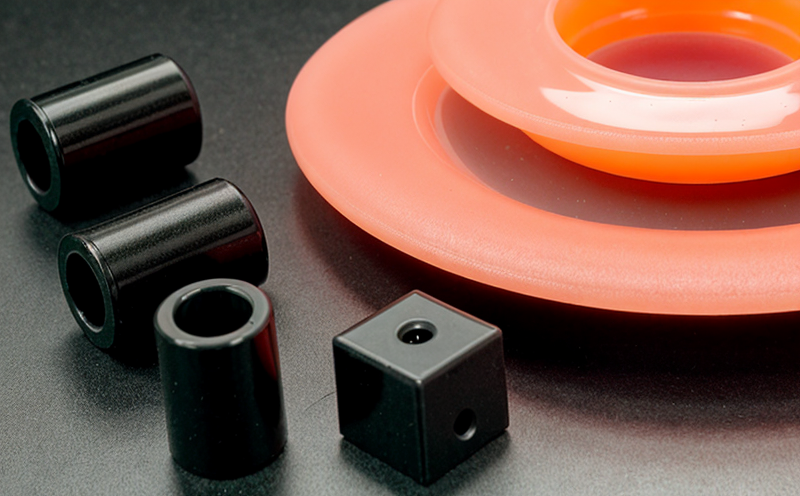ASTM G154 UV Resistance Testing of Plastic Sports Materials
The ASTM G154 UV Resistance Test is a critical procedure in evaluating the durability and longevity of plastic materials used in sports equipment. This test simulates the effects of ultraviolet (UV) light exposure, which is one of the primary factors that can degrade plastics over time. By subjecting samples to artificial sunlight using xenon arc lamps, this method provides insight into how well a material will withstand outdoor conditions, ensuring that sports gear remains safe and functional for extended periods.
Materials like polyethylene (PE), polystyrene (PS), acrylonitrile butadiene styrene (ABS), and various other plastics are commonly used in the production of sporting goods due to their strength, flexibility, and lightweight properties. However, these same desirable characteristics make them susceptible to UV degradation, leading to potential performance issues or safety hazards if not properly tested.
The ASTM G154 standard specifies a series of conditions under which test specimens must be exposed to simulate real-world UV exposure. These include temperature control, humidity levels, and the type of light source used during testing. Understanding these parameters is essential for accurate results that reflect actual use scenarios. Compliance with such standards helps manufacturers demonstrate adherence to industry best practices, thereby enhancing consumer trust.
When selecting a laboratory capable of conducting ASTM G154 UV Resistance Testing on sports plastics, it's important to look for expertise in polymer science combined with state-of-the-art facilities equipped specifically for this type of analysis. A reputable lab should offer detailed reports explaining the results, along with recommendations for improving material performance if necessary.
For quality managers and compliance officers working within the sporting goods industry, ensuring that all components meet or exceed relevant safety standards is crucial. Proper testing not only protects consumers but also contributes positively to brand reputation by showcasing commitment to excellence in product development. For R&D engineers tasked with creating new materials or improving existing ones, understanding how various factors affect UV resistance allows for more informed decisions regarding material selection and formulation.
Finally, procurement professionals benefit from knowing that third-party labs like ours provide reliable testing services which can help them source high-quality raw materials confidently. With accurate data about a supplier's products' UV resistance capabilities, they can make well-informed purchasing choices that align with broader business goals related to sustainability and longevity.
Why It Matters
UV radiation plays a significant role in the aging process of many plastics, particularly those used in outdoor sports equipment. Exposure to sunlight can cause discolored appearance changes, loss of mechanical properties such as tensile strength or impact resistance, and even complete degradation over time. These issues are especially problematic for lightweight materials often utilized in high-performance athletic gear where maintaining integrity is paramount.
By performing ASTM G154 UV Resistance Testing early in the design phase, manufacturers can identify potential shortcomings before committing resources to full-scale production runs. Early detection of problems allows for iterative improvement cycles aimed at optimizing material performance while minimizing costs associated with rework or scrap. Additionally, meeting regulatory requirements ensures compliance with international standards and helps protect brands from costly recalls.
Furthermore, demonstrating robust UV resistance through rigorous testing can serve as a competitive differentiator in today's crowded market. Consumers increasingly seek eco-friendly products that stand the test of time, making it advantageous for companies to showcase their commitment to sustainable practices via transparent communication around product durability.
Customer Impact and Satisfaction
Conducting ASTM G154 UV Resistance Testing offers numerous benefits to customers across different segments within the sports industry. For end-users, having durable, long-lasting equipment translates into increased satisfaction levels since they don't have to replace their gear as frequently. This reduced frequency of replacement contributes positively towards overall value perception, fostering brand loyalty.
For retailers and distributors, ensuring that products meet stringent quality benchmarks enhances confidence among customers regarding the reliability of purchased items. It also simplifies inventory management by reducing stock rotation rates for less frequently replaced goods. From a procurement standpoint, sourcing from suppliers who consistently deliver UV-resistant materials supports strategic planning efforts focused on meeting demand forecasts accurately.
Lastly, regulatory bodies responsible for enforcing safety regulations gain peace of mind knowing that manufacturers adhere to prescribed testing protocols. This alignment fosters trust between stakeholders involved in the supply chain ecosystem, ultimately leading to safer and more resilient products reaching end consumers.
Competitive Advantage and Market Impact
- Enhanced Product Durability: Demonstrating superior UV resistance through ASTM G154 testing provides a clear competitive edge by showcasing longer-lasting performance capabilities compared to competitors who may not prioritize this aspect.
- Eco-Friendly Image: Highlighting compliance with environmental standards can appeal to environmentally conscious consumers, contributing positively to brand image and market position.
- Safety Assurance: Providing evidence of rigorous testing instills confidence in customers about product safety, potentially reducing the risk of liability concerns or negative publicity associated with premature failures.
- Strategic Partnerships: Establishing relationships based on shared commitment to quality can lead to mutually beneficial collaborations that enhance mutual market presence and influence.
The combination of these factors contributes significantly to both short-term sales growth opportunities as well as long-term brand equity building, positioning businesses favorably within competitive landscapes.





